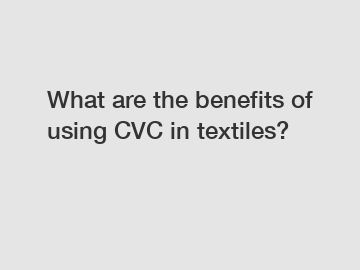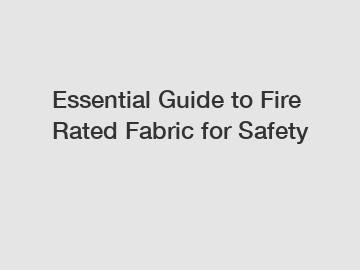What Are the Pros and Cons of Polyester Spandex?
What Are the Pros and Cons of Polyester Spandex?
When it comes to selecting the right fabric for clothing and activewear, many people find themselves pondering one question: what are the pros and cons of polyester spandex? This blend has gained immense popularity in recent years due to its unique properties and versatility. In this post, we will delve into the advantages and disadvantages of polyester spandex, helping you make a more informed choice about your next wardrobe addition.
If you want to learn more, please visit our website What Are the Pros and Cons of Polyester Spandex?.
Understanding Polyester Spandex
Before we explore the pros and cons, let’s break down what polyester spandex actually is. Polyester is a synthetic fiber known for its durability and resistance to shrinking and stretching. Spandex, on the other hand, is celebrated for its exceptional elasticity. When combined, these fabrics create a versatile material used in everything from athleisure wear to swimwear.
The Pros of Polyester Spandex
Exceptional Stretch and RecoveryOne of the most significant advantages of polyester spandex is its stretchability. This blend allows for great freedom of movement, making it a popular choice for athletic wear and form-fitting garments. After stretching, it returns to its original shape, ensuring your clothes retain their fit over time.
Moisture-Wicking PropertiesPolyester, by nature, has excellent moisture-wicking properties. This means it draws sweat away from the body, keeping you dry and comfortable during workouts or warm days. The addition of spandex enhances this feature, making it ideal for active lifestyles.
DurabilityBoth polyester and spandex are highly resistant to wear and tear. This durability allows garments made from this blend to withstand regular use and laundering without losing their shape or fading. This long-lasting quality makes it a worthwhile investment for your wardrobe.
Easy CarePolyester spandex blends are typically machine washable and quick drying. This ease of care makes it a practical choice for busy individuals who want low-maintenance clothing options.
Versatile Style OptionsThe fabric can be found in various styles, colors, and patterns. Whether you’re looking for a sleek pair of leggings or a chic dress, polyester spandex can provide a flattering fit and stylish appearance.
The Cons of Polyester Spandex
Heat RetentionOne downside of polyester spandex fabrics is their tendency to retain heat. They may not be the best choice for hot, humid climates or for people who easily overheat during physical activities.
Recommended article:
Ultimate Guide to Warp Knitting Scrub Cloth: Tips & Techniques
Diamond Cleaning Cloth: The Ultimate Guide to Sparkling Gems
How Can Flame-Retardant Knitted Materials Enhance Safety in Your Industry?
Weft Knit vs Warp Knit: Key Differences Explained for Knitting Enthusiasts
Mastering Warp Knitting: Essential Diagrams Explained
Bedding Fabric Manufacturer: Your Ultimate Guide to Quality Fabrics
How to Select Fire-Resistant Knitwear Material for Custom Designs?Limited BreathabilityWhile polyester is moisture-wicking, it doesn’t breathe as well as natural fibers like cotton. This can lead to discomfort in particularly hot conditions or during extended wear.
Environmental ImpactBoth polyester and spandex are synthetic materials derived from petroleum-based sources, which raises environmental concerns. The production of these fabrics can have a significant carbon footprint, and they are not biodegradable.
Skin SensitivitySome people may experience skin irritation or allergies from synthetic fabrics. It's crucial to consider this if you have sensitive skin or conditions like eczema.
PillingOver time, polyester spandex garments can develop pilling, which refers to the tiny balls of fabric that appear on the surface. This can detract from the overall appearance of your clothes, although it doesn’t typically affect functionality.
Summary and Conclusion
In summary, when evaluating what are the pros and cons of polyester spandex, it’s clear that this versatile blend has much to offer, particularly for those with active lifestyles. Its exceptional stretch, moisture-wicking properties, and durability make it a favored choice in modern apparel. However, potential drawbacks, such as heat retention and environmental impact, should also be considered.
If you are searching for stretchy, form-fitting clothing that can move with you, polyester spandex may be your answer. Just be mindful of your specific needs and preferences, such as climate and skin sensitivity.
Ready to explore the world of polyester spandex? Whether you’re shopping for workout gear or trendy outfits, keep these insights in mind. Happy shopping, and remember to choose what makes you feel comfortable and confident!
If you found this guide helpful, please share it with friends or leave a comment below with your experiences or tips related to polyester spandex!
For more information, please visit scrim fabric.
Recommended article:10 Tips You Should Know about Sustainable Denim Production Practices
Flame Retardant Cloth Custom vs. Standard Fabric: What's Best?
How Does Sustainable Packaging Design Work?
4 Tips to Select Fire-Resistant Woven Fabrics for Building Projects
How Fireproof Woven Fabric Custom Could Revolutionize Safety?
How Do Microfiber Scrub Cloth Prices Compare?
Top Benefits of Bamboo Microfiber Towels You Need










